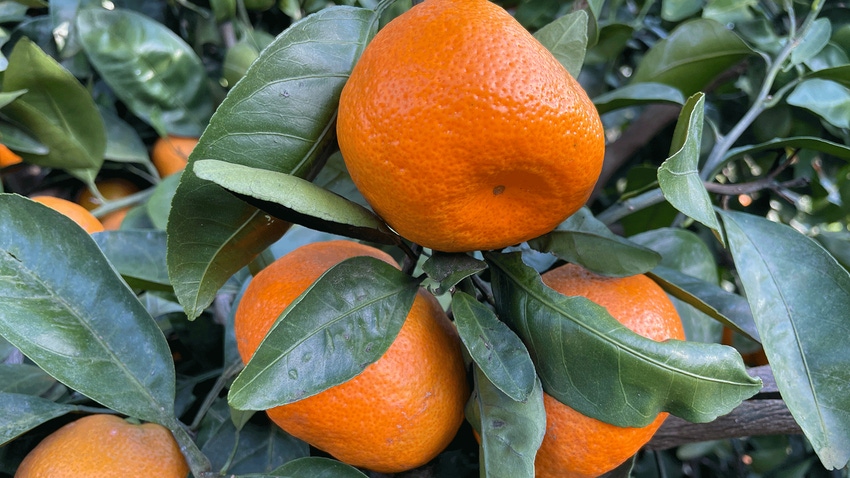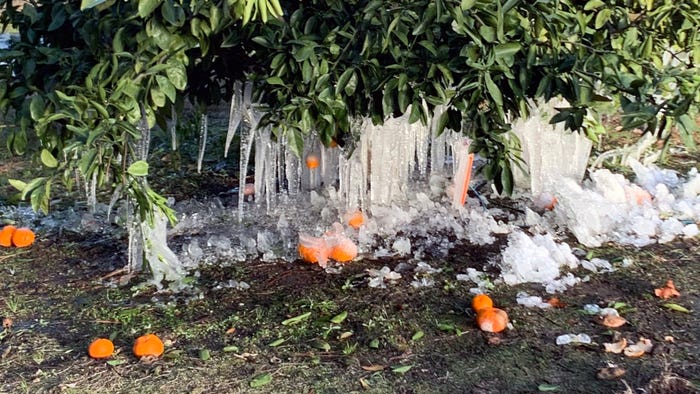
Deep freeze and growth test budding citrus industry
A few days before Christmas, Lindy and Perry Savelle hoped the plan would help the citrus trees make it through the hard, once-in-a-generation freeze just days away. But Lindy also had other things on her mind that day about the growing citrus industry in Georgia.

At a Glance
- Satsuma citrus growers, like the Savelles, use sprinklers to create a protective ice barrier on groves amid deep freezes.
- Cold-hardy satsuma citrus has grown in popularity over the last decade, and trees can produce over 50,000 pounds of fruit.
- There are currently two Georgia packing facilities for citrus and one in north Florida.
A few days before Christmas, Lindy and Perry Savelle hoped the plan would help the citrus trees make it through the hard, once-in-a-generation freeze just days away. But Lindy also had other things on her mind that day about the growing citrus industry in Georgia.
The Savelles have a commercial citrus grove in Thomas County near the Florida line. Loads of fruit remained on the trees Dec. 19, even after three times picked over for the season, so it was a race till the end to get it all picked and sold before the freeze came. Lindy was one of the earliest champions of Georgia’s growing citrus industry. She is president of the Georgia Citrus Association.
Seven years ago, after Lindy retired from a decades-long successful career in global law enforcement, the Savelles wanted a way to use some of Perry’s family farm, named JoNina Farm. Citrus looked like the best and most-rewarding bang for the effort.
“And since then and in the last six to seven years, the citrus industry in Georgia has exploded exponentially,” she said.
Interest in commercial citrus production in Georgia started more than a decade ago, particularly production of the cold-hardy satsuma variety.

Lindy Savelle was one of the earliest champions of Georgia’s growing citrus industry. She is president of the Georgia Citrus Association. (Photo By Brad Haire)
Growth
According to University of Georgia Extension and Georgia citrus industry estimates, a decade ago Georgia had about 4,500 planted commercial citrus trees, again mostly satsuma. Today, there are about 473,000 commercial citrus trees planted on roughly 4,000 acres.
“And those are just the acres we know of,” she said. “There’s likely more than that planted or in the process of being planted. … And ultimately and before long, I think we may have 35,000 to 40,000 planted acres in the state.”
She and others started the Georgia Citrus Association in October 2016 with 27 members, she said. Within 5 months, the association held its first conference which over 278 interested people attended. Today, GCA has over 100 members and each year hundreds of people go to the conference.
Satsuma growers plant about 150-175 trees per acre on average. One tree reaching maturity can produce 350 pounds or more of fruit. But not all fruit is marketable. “For every one you pick that is marketable, you’ll pick one that is not. You’ll have some ‘ugly babies.’”
An acre of mature citrus trees can provide 50,000 pounds or more of total fruit, ‘ugly babies’ and all. At between 25 cents to a dollar per pound, depending on severity of the ugly, an acre of citrus can be profitable, which is why the industry continues to grow.
Agronomically, growers spray orchards with insecticides and fungicides about every two weeks leading up to harvest, like another one of Georgia’s notable orchard crops, the pecan.
There are two packing facilities for citrus now in Georgia and one in north Florida, but more packing capacity will be needed, she said, as the trees planted four and five years ago reach fuller maturity and production potential. She said the larger growers now, those with hundreds of planted acres, typically have access or are invested in the existing packing plants. That is a good thing and shows the demand and growth as the industry continues to trend higher.
Back when the Savelles started their citrus grove, growers like them with five to 10 acres were considered large. But not today. Larger growers now count acres in the hundreds. The Savelles are shifting their business to grow the nursery side of their operation, Georgia Grown Citrus, providing as much as 50,000 trees of many citrus varieties annually to commercial growers and homeowners through an on-the-farm and online business.
They are also honing the agritourism side of the farm, offering seasonal clip-your-own fruit days where visitors take a tractor ride, wander the citrus grove and take pictures on one of Perry’s old tractors or on Clementine, Lindy’s Orange ‘64 Ford pickup.
She said smaller growers like JoNina Farm are the backbone of Georgia's citrus industry and they need continued access to packing facilities to market their fruit. Creating additional packing access for smaller growers is a new focus for her. Investors have approached Lindy about creating a co-operative business model and facility for smaller growers in the area.

The Artic Blast hit the Savelles’ orchard Dec. 23. For the next several days, daytime temperatures didn’t rise above freezing. They used sprinklers to spray trees with water to form a protective ice sheet, particularly around the trees’ ‘bud graft’ about one to two feet up the trunk from the ground. (Photo courtesy of Lindy Savelle)
The Freeze
The Artic blast hit the Savelles’ orchard Dec. 23. For the next several days, daytime temperatures did not rise above freezing. The last time a system of similar freezing ferocity hit the region was four decades ago. Satsuma citrus can survive subfreezing temperatures, but the trees had not faced weather like this before.
The Savelles and other prepared citrus growers used sprinklers to spray trees with water to form a protective ice sheet, particularly around the trees’ ‘bud graft’ about one to two feet up the trunk from the ground.
The Savelles turned on their microjets at 36 degrees. Once they started the process, there was no turning back until the temperatures rose far above freezing, she said.
Fast forward to an early spring in the region. As March brought warmer-than-normal weather, Savelle said the trees “have gone from looking like bald cypress trees to blooming citrus trees. Nature is quite amazing.”
About the Author(s)
You May Also Like





